Microstructure and Mechanical Properties of Mg-Al-La-Mn Composites Reinforced by AlN Particles
Abstract
:1. Introduction
2. Materials and Methods
2.1. Preparation of AlN/AE44 Composites
2.2. Microstructural Characterization
2.3. Mechanical Characterization
3. Results and Discussion
3.1. In Situ 40 wt.% AlN/Mg Master Alloy
3.2. Microstructure of AlN/AE44 Composites
3.3. Mechanical Properties of AlN/AE44 Composites
3.3.1. Mechanical Properties of AlN/AE44 Composites at Room Temperature
3.3.2. Mechanical Properties of AlN/AE44 Composites at High Temperatures
4. Conclusions
- The addition of AlN particles effectively refines the grain size of the AE44 matrix alloy and reduces the size of the second phases (Al11La3, Al2La, Al3La), as well as improving the distribution of the second phase. The average grain size, Al11La3 phase, Al2La phase, and Al3La phase of the 2.0 wt.% AlN/AE44 composite are 135.7, 9.6, 1.9, and 12.6 μm, respectively, which are significantly lower than those of the AE44 matrix alloy (179.8, 12.6, 3.3, 17.8 μm).
- The 2.0 wt.% AlN/AE44 composite shows the optimal combination of strength and plasticity at room temperature, with TYS, UTS, and EL values of 96 MPa, 175 MPa, and 7.0%, respectively. The outstanding mechanical properties of the 2.0 wt.% AlN/AE44 composite can be attributed to the synergistic effects of second-phase strengthening, load transfer strengthening, and thermal mismatch strengthening.
- At elevated temperatures (150–250 °C), the performance of the composite exhibits minimal degradation with increasing temperature due to the pinning effect of AlN particles on grain boundaries and enhanced dislocation climbing stress, resulting in excellent mechanical properties at high temperatures.
Author Contributions
Funding
Institutional Review Board Statement
Informed Consent Statement
Data Availability Statement
Conflicts of Interest
References
- Rong, W.; Zhang, Y.; Wu, Y.J.; Chen, Y.L.; Tang, T.; Peng, L.M.; Li, D.Y. Fabrication of high-strength Mg-Gd-Zn-Zr alloys via differential-thermal extrusion. Mater. Charact. 2017, 131, 380–387. [Google Scholar] [CrossRef]
- Yu, S.; Wan, Y.; Liu, C.; Chen, Z.; Zhou, X. Twinning-induced abnormal strain rate sensitivity and indentation creep behavior in nanocrystalline Mg alloy. Materials 2021, 14, 7104. [Google Scholar] [CrossRef] [PubMed]
- Joost, W.J.; Krajewski, P.E. Towards magnesium alloys for high-volume automotive applications. Scr. Mater. 2017, 128, 107–112. [Google Scholar] [CrossRef]
- Shi, H.L.; Xu, C.; Hu, X.S.; Gan, W.M.; Wu, K.; Wang, X.J. Improving the Young’s modulus of Mg via alloying and compositing—A short review. J. Magnes. Alloys 2022, 10, 2009–2024. [Google Scholar] [CrossRef]
- Jin, Z.Z.; Zha, M.; Wang, S.Q.; Wang, S.C.; Wang, C.; Jia, H.L.; Wang, H.Y. Alloying design and microstructural control strategies towards developing Mg alloys with enhanced ductility. J. Magnes. Alloys 2022, 10, 1191–1206. [Google Scholar] [CrossRef]
- Nakata, T.; Xu, C.; Kaibe, K.; Yoshida, Y.; Yoshida, K.; Kamado, S. Improvement of strength and ductility synergy in a room-temperature stretch-formable Mg-Al-Mn alloy sheet by twin-roll casting and low-temperature annealing. J. Magnes. Alloys 2022, 10, 1066–1074. [Google Scholar] [CrossRef]
- Weiler, J.P. Exploring the concept of castability in magnesium die-casting alloys. J. Magnes. Alloys 2021, 9, 102–111. [Google Scholar] [CrossRef]
- Alaneme, K.K.; Okotete, E.A. Enhancing plastic deformability of Mg and its alloys—A review of traditional and nascent developments. J. Magnes. Alloys 2017, 5, 460–475. [Google Scholar] [CrossRef]
- Kumar, A.; Meenashisundaram, G.K.; Manakari, V.; Parande, G.; Gupta, M. Lanthanum effect on improving CTE, damping, hardness and tensile response of Mg-3Al alloy. J. Alloys Compd. 2017, 695, 3612–3620. [Google Scholar] [CrossRef]
- Li, L.; Li, D.J.; Zeng, X.Q.; Luo, A.A.; Hu, B.; Sachdev, A.V.; Gu, L.L.; Ding, W.J. Microstructural evolution of Mg-Al-Re alloy reinforced with alumina fibers. J. Magnes. Alloys 2020, 8, 565–577. [Google Scholar] [CrossRef]
- Liu, Y.F.; Jia, X.J.; Qiao, X.G.; Xu, S.W.; Zheng, M.Y. Effect of La content on microstructure, thermal conductivity and mechanical properties of Mg–4Al magnesium alloys. J. Alloys Compd. 2019, 806, 71–78. [Google Scholar] [CrossRef]
- Chen, Q.; Chen, G.; Han, L.N.; Hu, N.; Han, F.; Zhao, Z.D.; Xia, X.S.; Wan, Y.Y. Microstructure evolution of SiCp/ZM6 (Mg–Nd–Zn) magnesium matrix composite in the semi-solid state. J. Alloys Compd. 2016, 656, 67–76. [Google Scholar] [CrossRef]
- Mehra, D.; Mahapatra, M.M.; Harsha, S.P. Processing of RZ5-10wt%TiC in-situ magnesium matrix composite. J. Magnes. Alloys 2018, 6, 100–105. [Google Scholar] [CrossRef]
- Wang, W.X.; Chen, X.G.; Liu, J.; Liu, D.C.; Liu, Z.Z.; Li, W.Z.; He, N. Effects of TiB2 nanoparticles and ultrasonic vibration on the mechanical properties of an Mg-4Al-1.5Si alloy. J. Alloys Compd. 2022, 912, 165213. [Google Scholar] [CrossRef]
- Sahoo, S.K.; Panigrahi, S.K. Comparative study on high temperature deformation behavior and processing maps of Mg-4Zn-1RE-0.5Zr alloy with and without in-situ sub-micron sized TiB2 reinforcement. J. Magnes. Alloys 2022, 10, 3520–3541. [Google Scholar] [CrossRef]
- Hassan, S.F.; Gupta, M. Development of a novel magnesium/nickel composite with improved mechanical properties. J. Alloys Compd. 2002, 335, 10–15. [Google Scholar] [CrossRef]
- Chen, J.; Bao, C.G.; Ma, Y.N.; Chen, Z.H. Distribution control of AlN particles in Mg-Al/AlN composites. J. Alloys Compd. 2017, 695, 162–170. [Google Scholar] [CrossRef]
- Yang, C.L.; Zhang, B.; Zhao, D.C.; Lu, H.B.; Zhai, T.G.; Liu, F. Microstructure and mechanical properties of AlN particles in situ reinforced Mg matrix composites. Mater. Sci. Eng. A 2016, 674, 158–163. [Google Scholar] [CrossRef]
- Kumari, S.S.S.; Pillai, U.T.S.; Pai, B.C. Synthesis and characterization of in situ Al–AlN composite by nitrogen gas bubbling method. J. Alloys Compd. 2011, 509, 2503–2509. [Google Scholar] [CrossRef]
- Chen, J.; Bao, C.G.; Wang, Y.; Liu, J.L.; Challapalli, S. Microstructure and lattice parameters of AlN particle-reinforced magnesium matrix composites fabricated by powder metallurgy. Acta Metall. Sin. Engl. Lett. 2015, 28, 1354–1363. [Google Scholar] [CrossRef]
- Chen, J.; Bao, C.G.; Chen, F.L. Evolutions of microstructure and mechanical properties for Mg-Al/AlN composites under hot extrusion. Mater. Sci. Eng. A 2016, 667, 426–434. [Google Scholar] [CrossRef]
- GB/T228.1-2010; Metallic Materials—Tensile Testing—Part 1: Method of Test at Room Temperature. Standardization Administration of the People’s Republic of China: Beijing, China, 2010.
- GB/T228.2-2015; Metallic Materials—Tensile Testing—Part 2: Method of Test at Elevated Temperature. Standardization Administration of the People’s Republic of China: Beijing, China, 2015.
- Fu, H.M.; Zhang, M.X.; Qiu, D.; Kelly, P.M.; Taylor, J.A. Grain refinement by AlN particles in Mg–Al based alloys. J. Alloys Compd. 2009, 478, 809–812. [Google Scholar] [CrossRef]
- Zhao, X.; Yang, Z.; Dong, X. Effect of adding AlN ceramic particles on the micromorphology of the Mg17Al12 phase in magnesium alloys. Adv. Eng. Mater. 2021, 23, 2100375. [Google Scholar] [CrossRef]
- Yan, X.; Sugio, K.; Choi, Y.; Wang, T.S.; Zhao, C.Z.; Sasaki, G. Thermal expansion behavior and analysis of Al/AlN interpenetrating phase composites with different preform porosity. J. Mater. Res. Technol. 2024, 30, 1539–1546. [Google Scholar] [CrossRef]
- Chen, J.; Bao, C.G.; Liu, Z.W.; Sun, B.S.; Shu, Y.C.; Li, Q.K. Thermal properties of Mg–Al/AlN composites fabricated by powder metallurgy. Acta Metall. Sin. Engl. Lett. 2018, 31, 641–649. [Google Scholar] [CrossRef]
- Hu, K.Q.; Xu, Q.F.; Ma, X.; Sun, Q.Q.; Gao, T.; Liu, X.F. A novel heat-resistant Al–Si–Cu–Ni–Mg base material synergistically strengthened by Ni-rich intermetallics and nano-AlNp microskeletons. J. Mater. Sci. Technol. 2019, 35, 306–312. [Google Scholar] [CrossRef]
- Qin, P.F.; Yang, Q.; He, Y.Y. Microstructure and mechanical properties of high-strength high-pressure die-cast Mg–4Al–3La–1Ca–0.3Mn alloy. Rare Met. 2021, 40, 2956–2963. [Google Scholar] [CrossRef]
- Sankaranarayanan, S.; Habibi, M.K.; Jayalakshmi, S.; Ai, K.J.; Almajid, A.; Gupta, M. Nano-AlN particle reinforced Mg composites: Microstructural and mechanical properties. Mater. Sci. Technol. 2015, 31, 1122–1131. [Google Scholar] [CrossRef]
- Giannopoulou, D.; Dieringa, H.; Bohlen, J. Influence of AlN Nanoparticle Addition on Microstructure and mechanical properties of extruded pure magnesium and an aluminum-free Mg-Zn-Y alloy. Metals 2019, 9, 667. [Google Scholar] [CrossRef]
- Trang, T.T.T.; Zhang, J.H.; Kim, J.H.; Zargaran, A.; Hwang, J.H.; Suh, B.C.; Kim, N.J. Designing a magnesium alloy with high strength and high formability. Nat. Commun. 2018, 9, 2522–2526. [Google Scholar] [CrossRef]
- Xie, K.W.; Nie, J.F.; Hu, K.Q.; Ma, X.; Liu, X.F. Improvement of high-temperature strength of 6061 Al matrix composite reinforced by dual-phased nano-AlN and submicron-Al2O3 particles. Trans. Nonferrous Met. Soc. China 2022, 32, 3197–3211. [Google Scholar] [CrossRef]
- Cao, G.; Choi, H.; Oportus, J.; Konishi, H.; Li, X. Study on tensile properties and microstructure of cast AZ91D/A1N nanocomposites. Mater. Sci. Eng. A 2008, 494, 127–131. [Google Scholar] [CrossRef]
- Poletti, C.; Balog, M.; Simancik, F.; Degischer, H.P. High-temperature strength of compacted sub-micrometer aluminium powder. Acta Mater. 2010, 58, 3781–3789. [Google Scholar] [CrossRef]
- Zhang, J.H.; Liu, K.; Fang, D.Q.; Qiu, X.; Tang, D.X.; Meng, J. Microstructure, tensile properties, and creep behavior of high-pressure die-cast Mg-4Al-4RE-0.4Mn (RE = La, Ce) alloys. J. Mater. Sci. 2009, 44, 2046–2054. [Google Scholar] [CrossRef]
- Zhang, J.H.; Zhang, M.L.; Meng, J.; Wu, R.Z.; Tang, D.X. Microstructures and mechanical properties of heat-resistant high-pressure die-cast Mg-4A1-xLa-0.3Mn (x = 1, 2, 4, 6) alloys. Mater. Sci. Eng. A 2010, 527, 2527–2537. [Google Scholar] [CrossRef]
- Zhang, J.H.; Zhang, D.P.; Tian, Z.; Wang, J.; Liu, K.; Lu, H.Y.; Tang, D.X.; Meng, J. Microstructures, tensile properties and corrosion behavior of die-cast Mg-4Al-based alloys containing La and/or Ce. Mater. Sci. Eng. A 2008, 489, 113–119. [Google Scholar] [CrossRef]

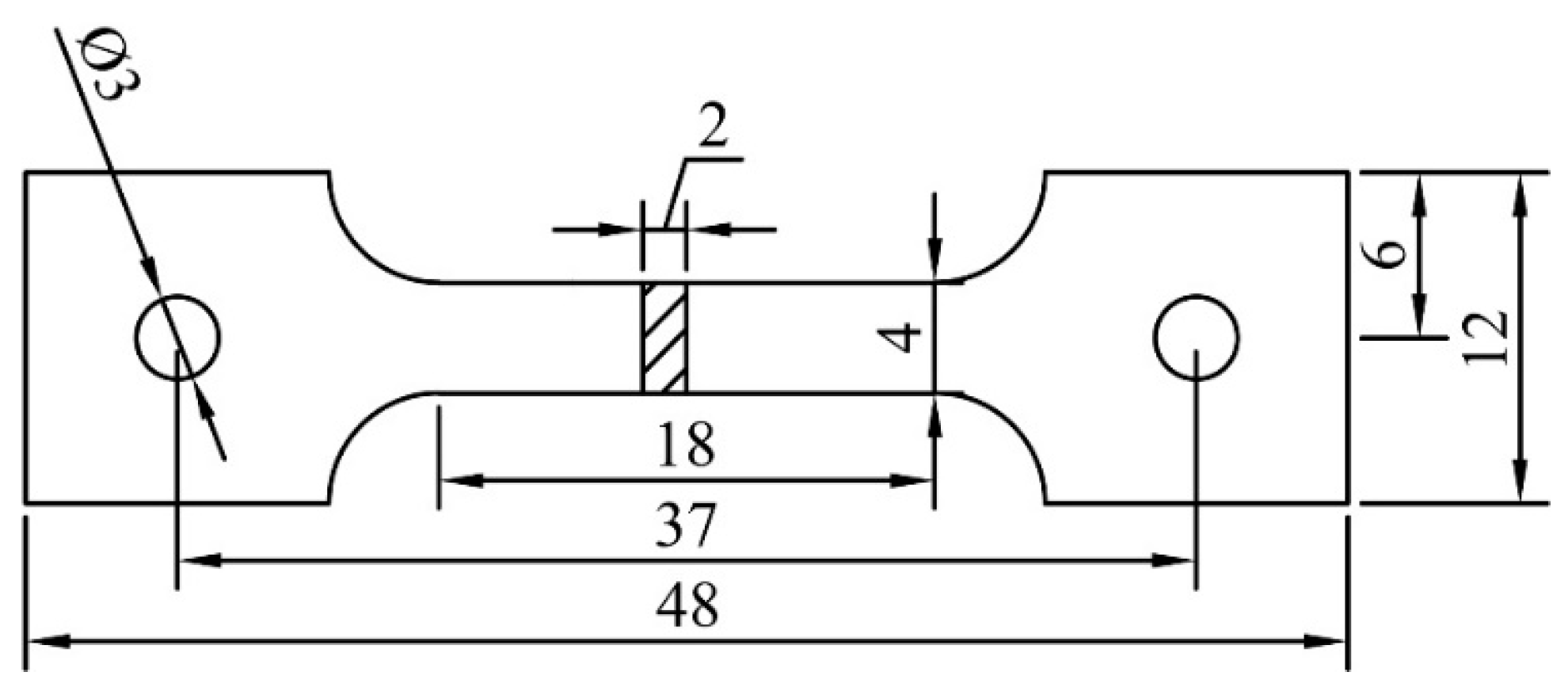
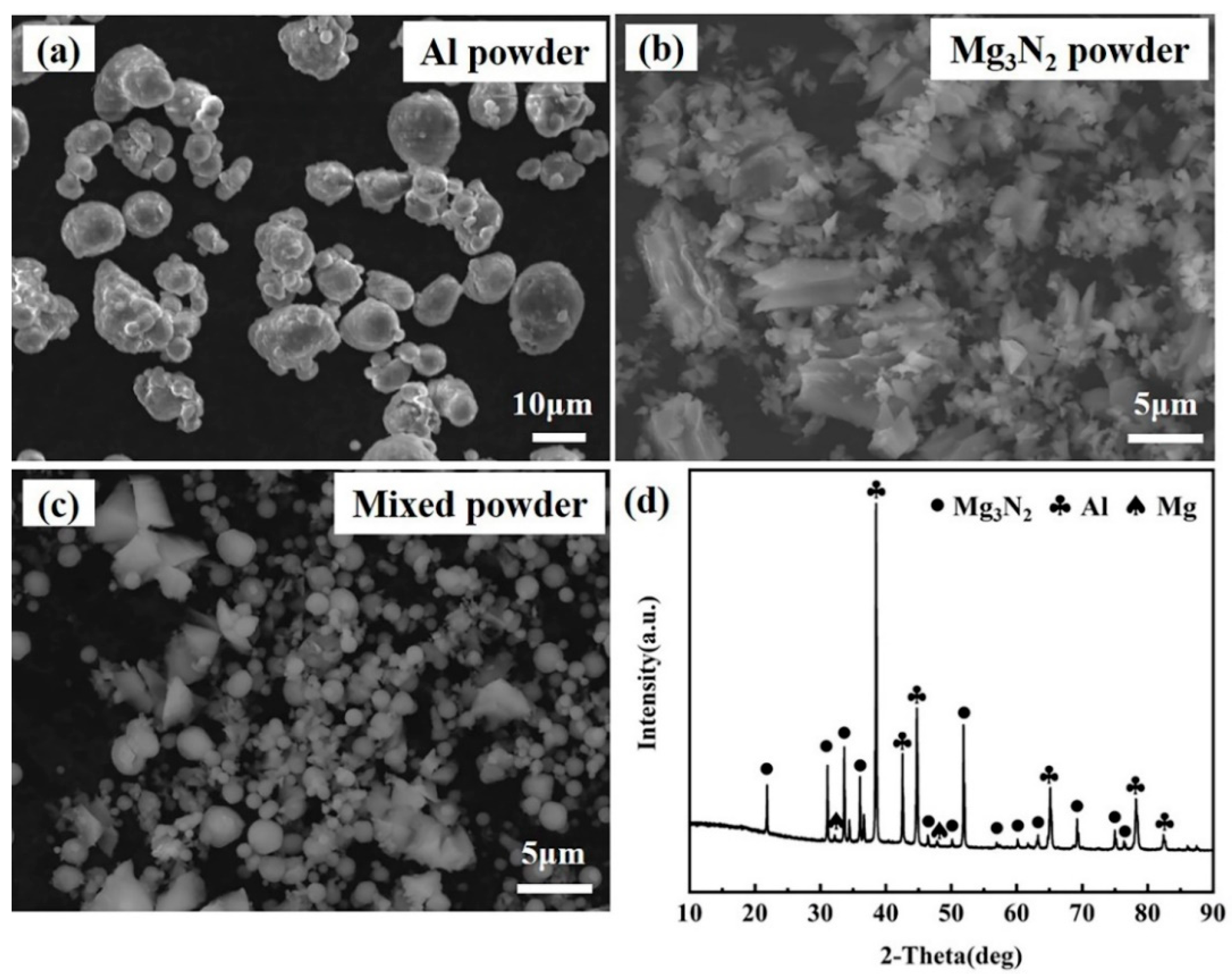


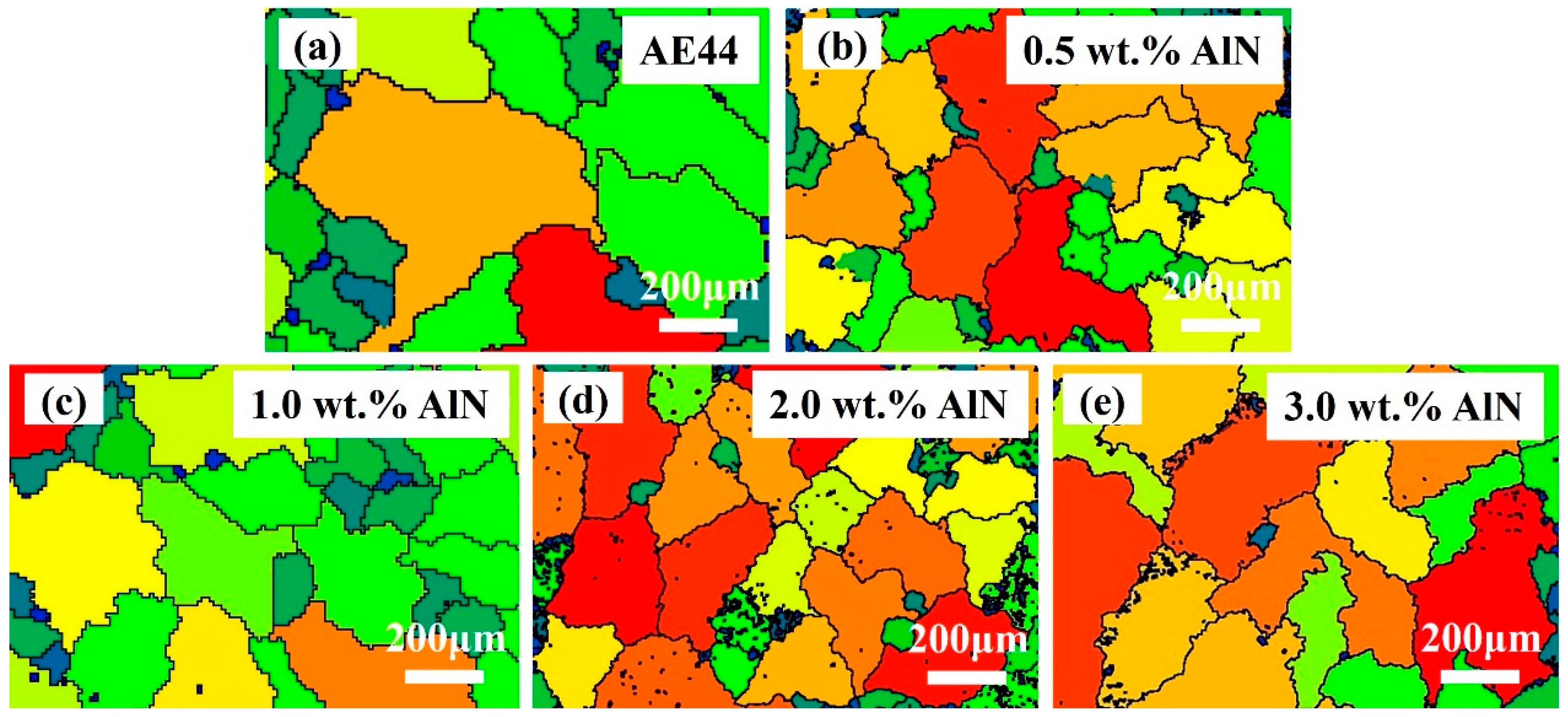
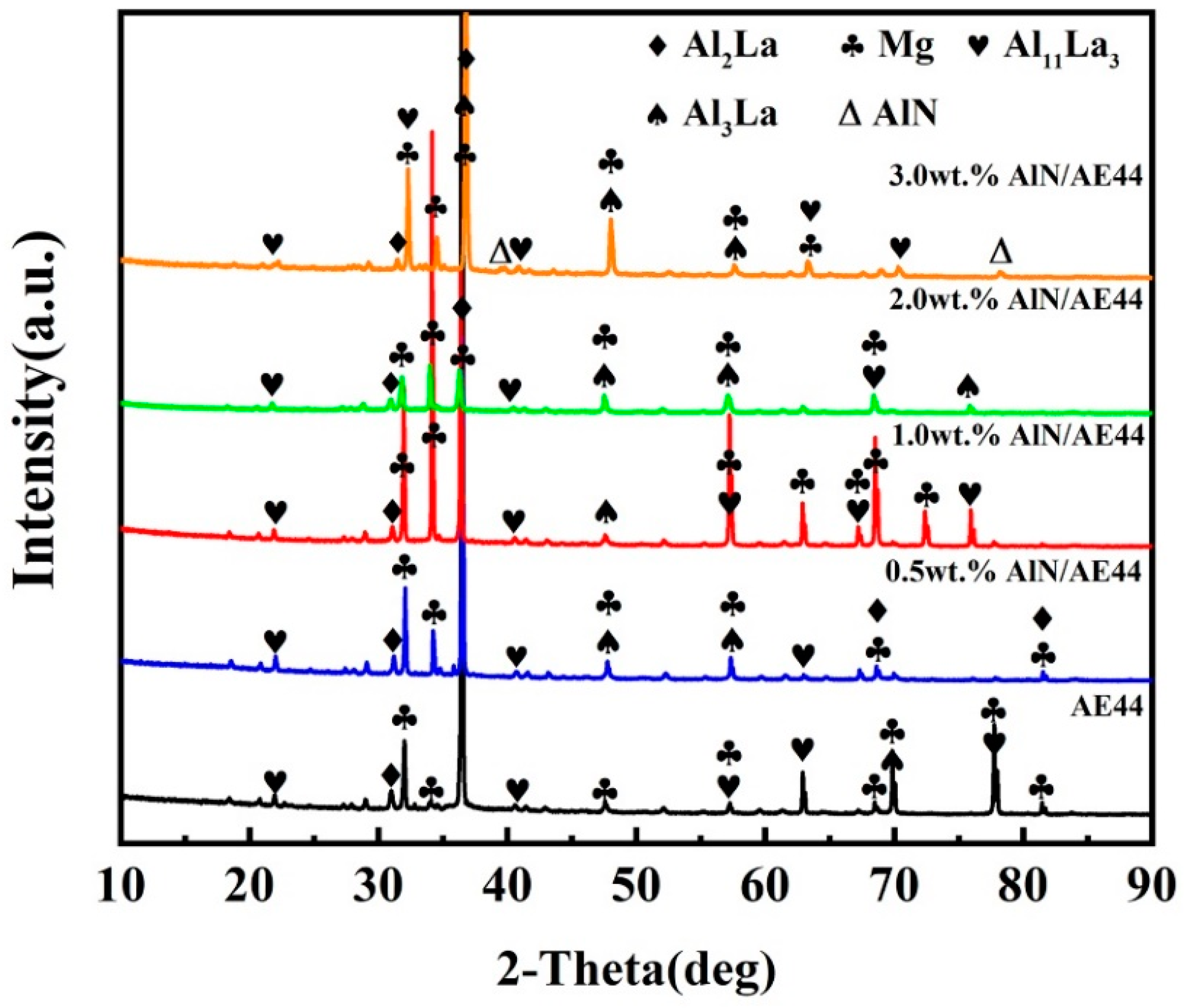
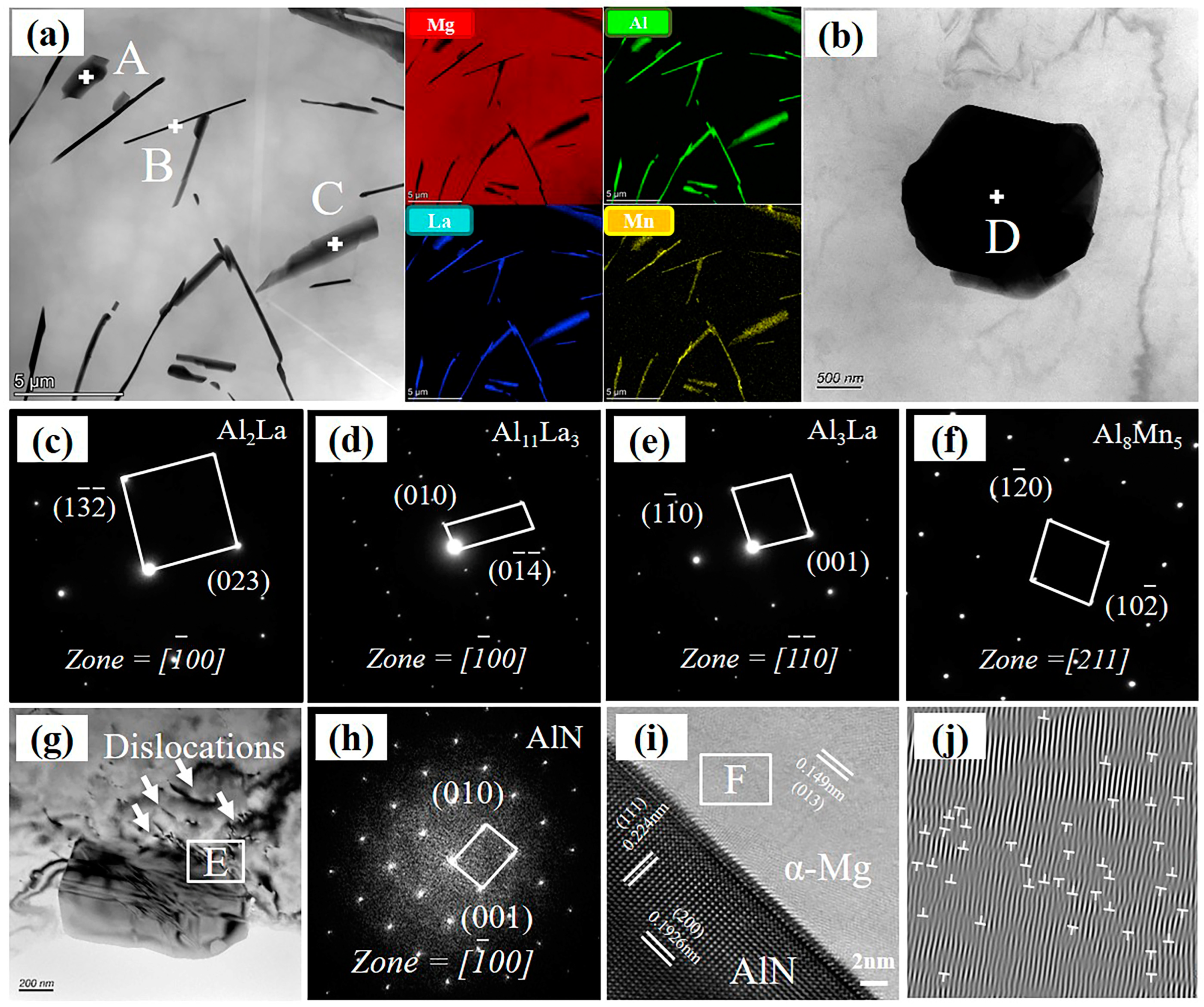
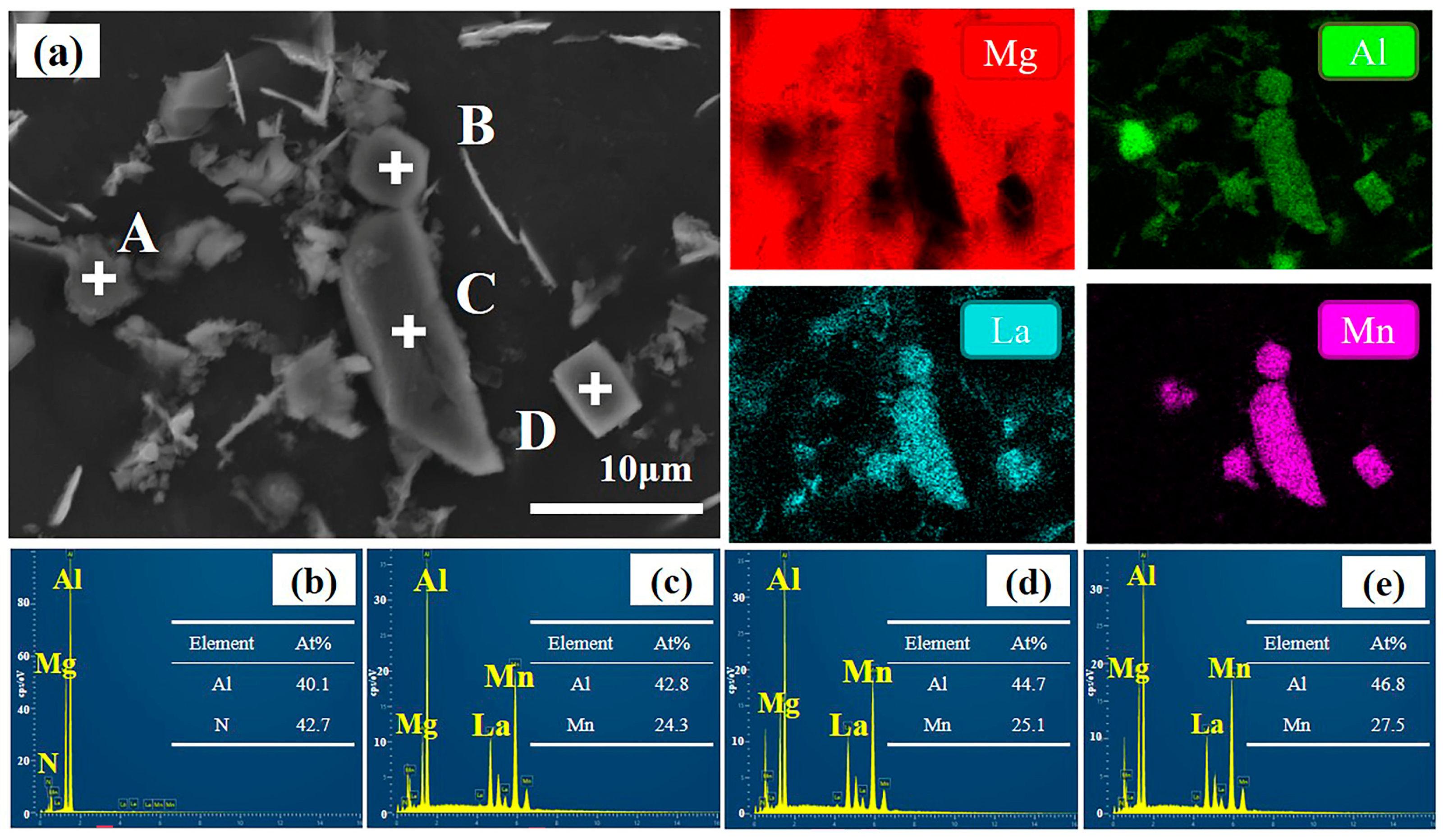
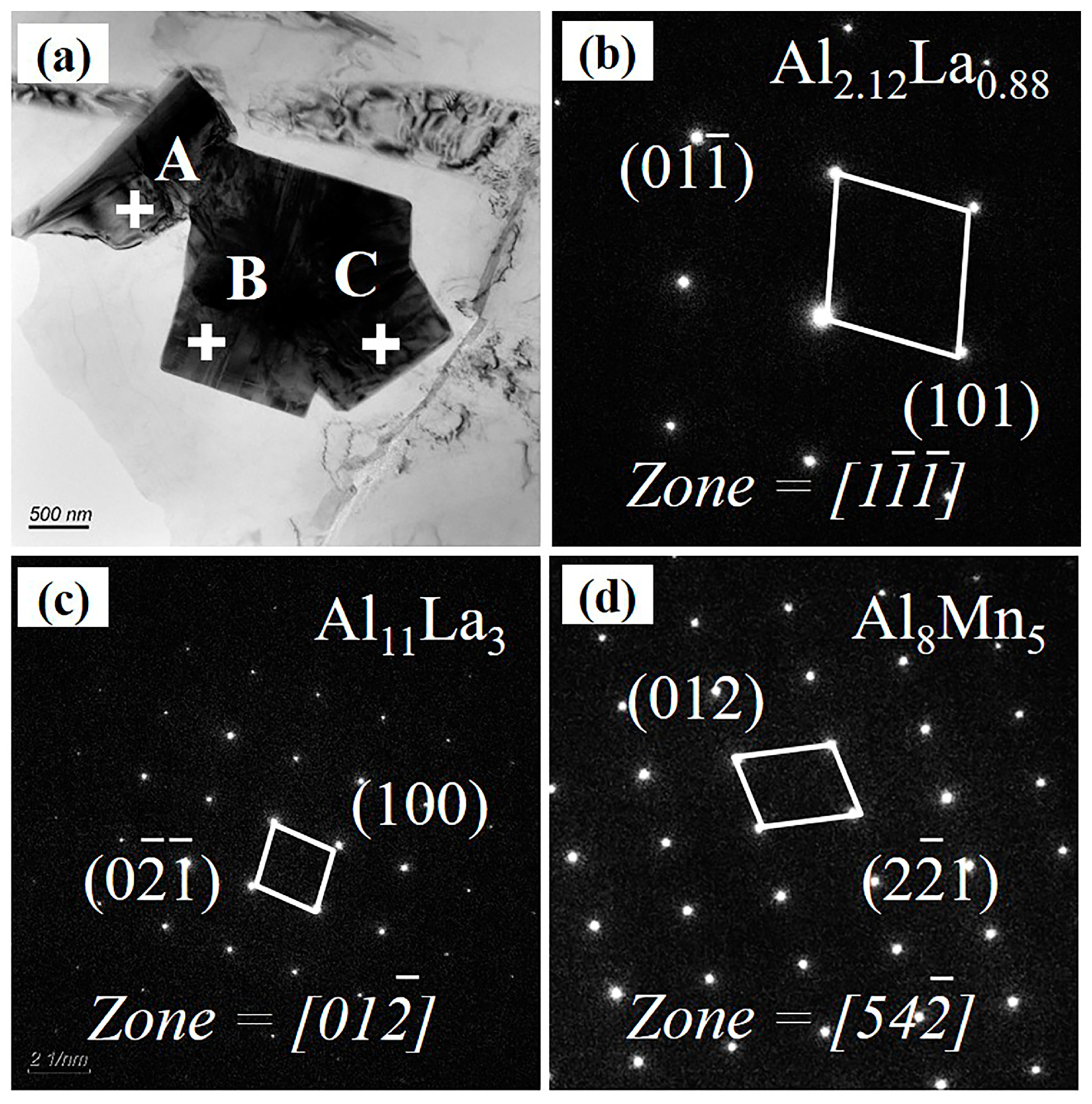
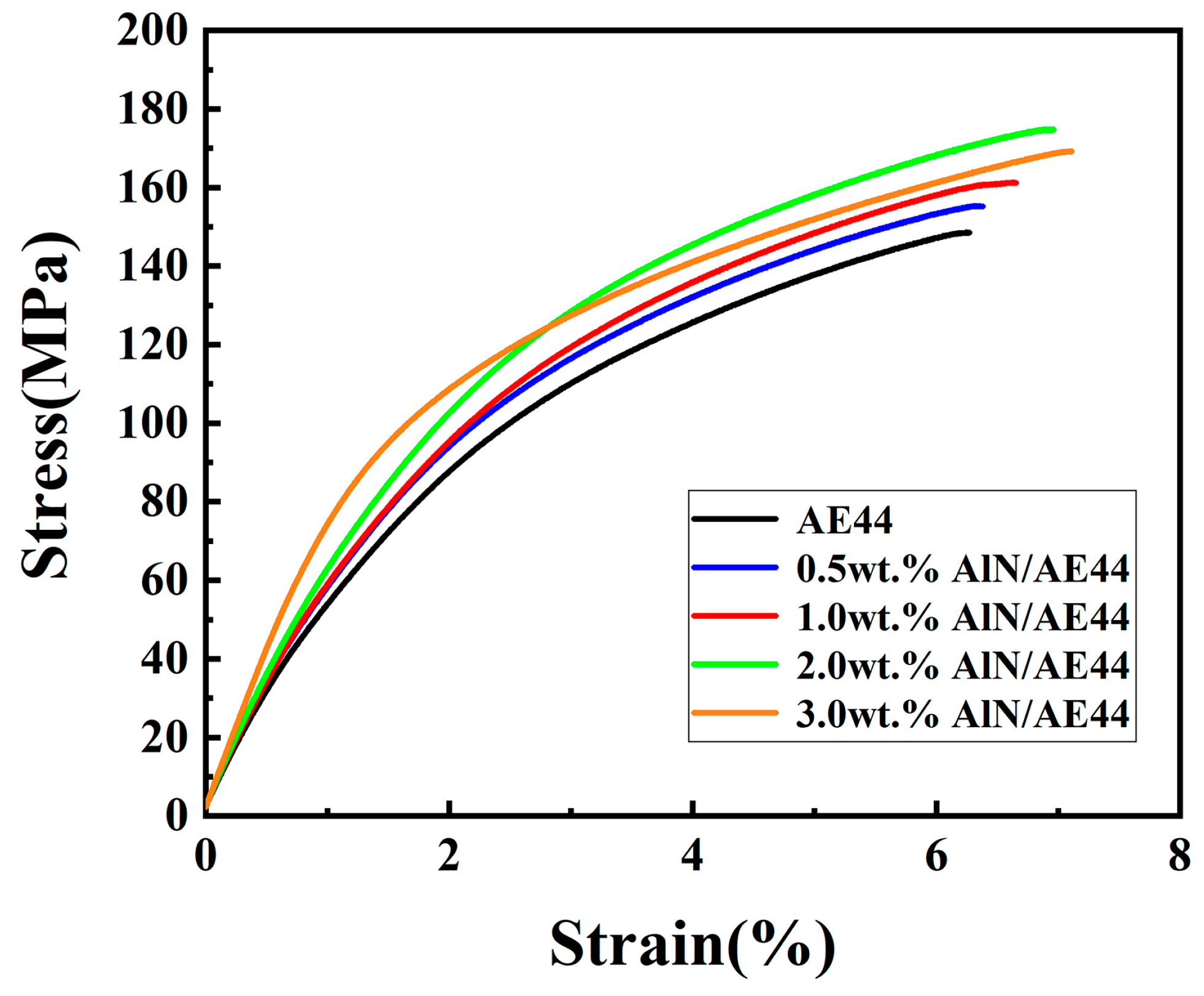


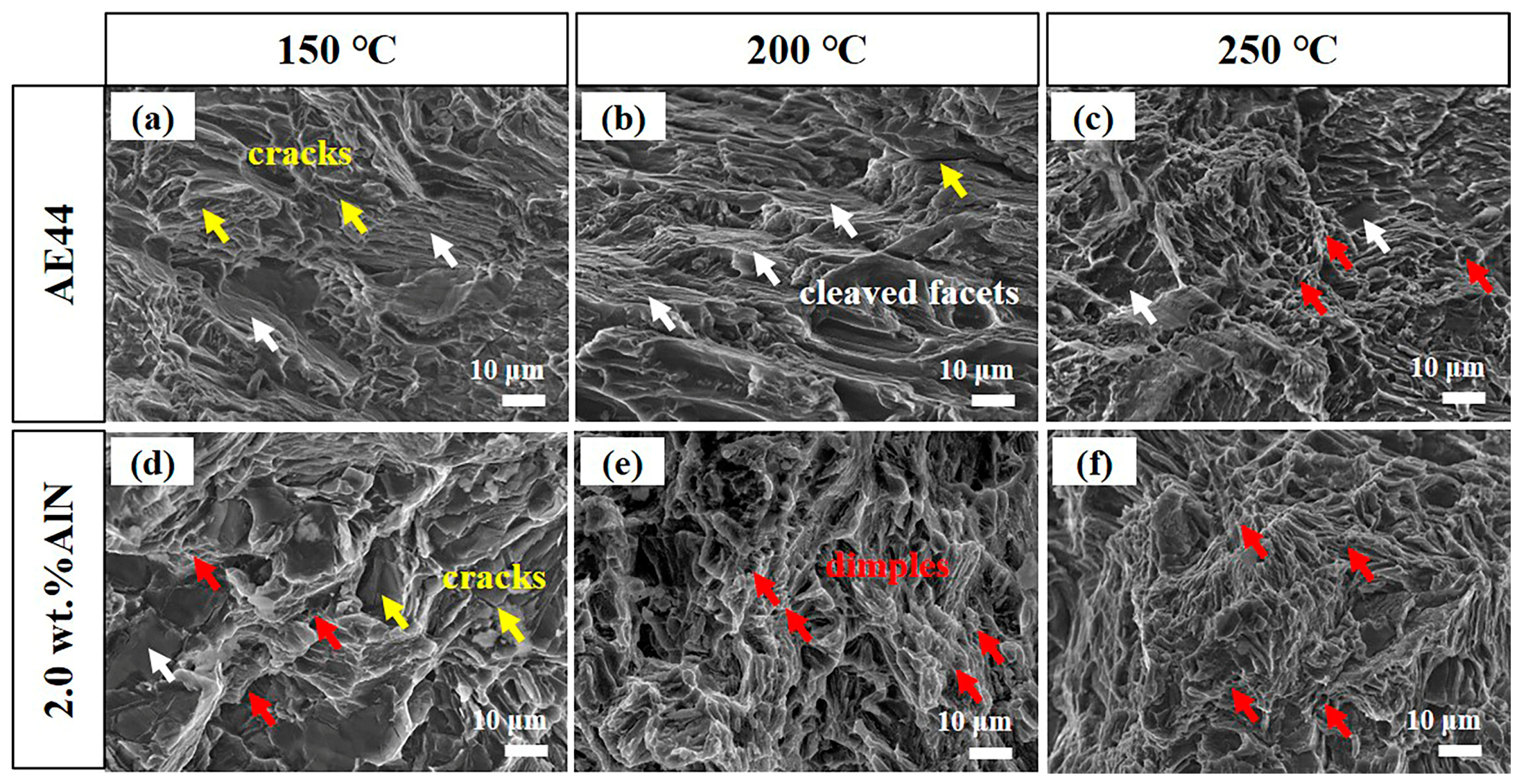
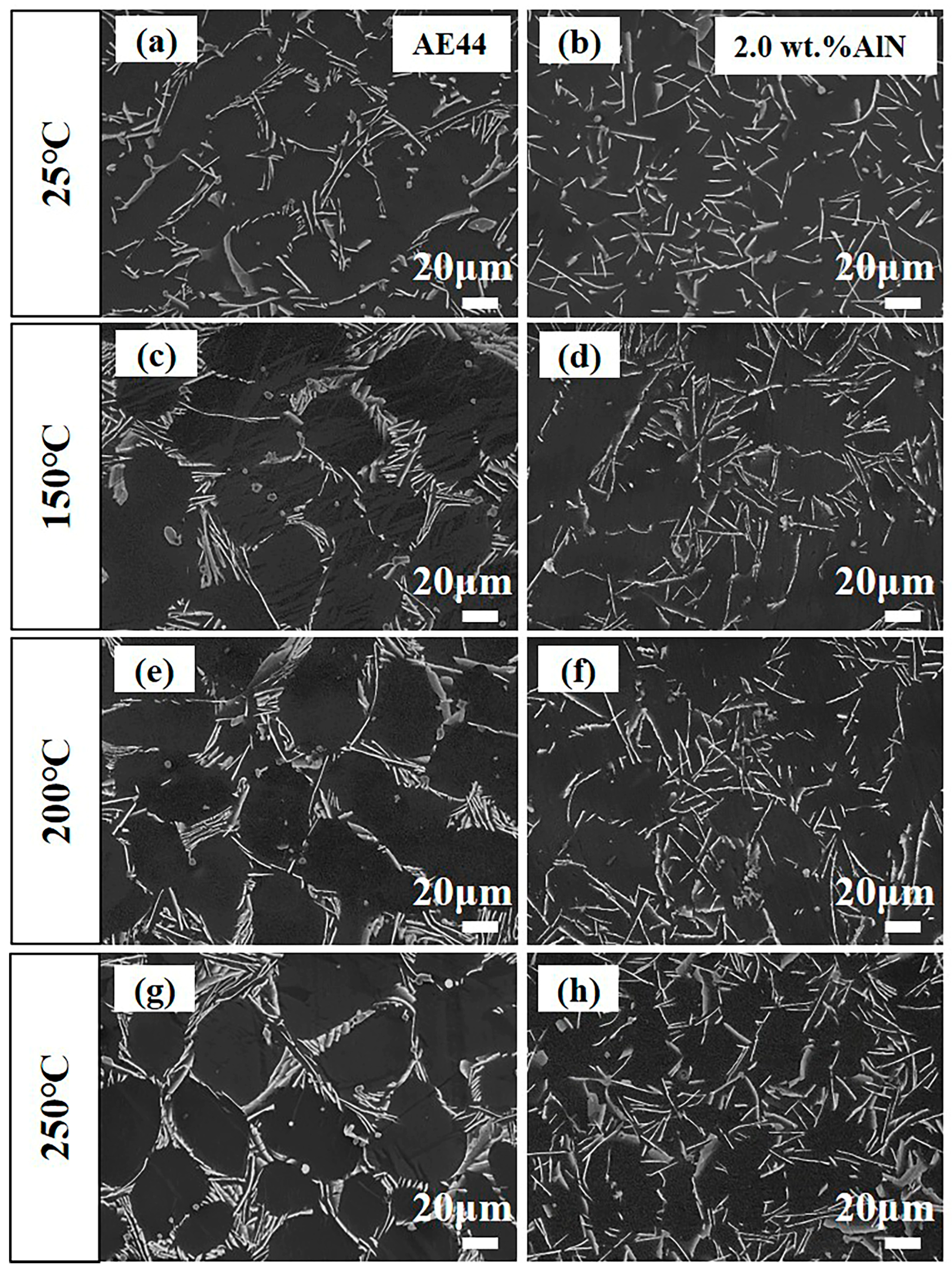
| Samples | σ0.2/MPa | σUTS/MPa | ε/% |
|---|---|---|---|
| AE44 | 70 ± 2 | 148 ± 3 | 6.3 ± 0.3 |
| 0.5 wt.% AlN | 82 ± 1 | 155 ± 2 | 6.4 ± 0.5 |
| 1.0 wt.% AlN | 90 ± 3 | 161 ± 1 | 6.7 ± 0.2 |
| 2.0 wt.% AlN | 96 ± 2 | 175 ± 2 | 7.0 ± 0.2 |
| 3.0 wt.% AlN | 99 ± 4 | 169 ± 5 | 7.0 ± 0.4 |
| Samples | 150 °C | 200 °C | 250 °C | ||||||
|---|---|---|---|---|---|---|---|---|---|
| σ0.2/MPa | σUTS/MPa | ε/% | σ0.2/MPa | σUTS/MPa | ε/% | σ0.2/MPa | σUTS/MPa | ε/% | |
| AE44 | 56 ± 3 | 120 ± 4 | 8.5 ± 0.4 | 57 ± 4 | 115 ± 3 | 10.0 ± 0.3 | 45 ± 4 | 110 ± 3 | 16.3 ± 0.3 |
| 1.0 wt.% AlN | 63 ± 2 | 137 ± 3 | 9.1 ± 0.3 | 65 ± 3 | 125 ± 3 | 10.5 ± 0.4 | 56 ± 3 | 105 ± 2 | 10.7 ± 0.4 |
| 2.0 wt.% AlN | 73 ± 2 | 145 ± 2 | 11.5 ± 0.2 | 71 ± 2 | 129 ± 1 | 12.4 ± 0.2 | 67 ± 3 | 120 ± 2 | 11.2 ± 0.3 |
| 3.0 wt.% AlN | 79 ± 3 | 143 ± 4 | 6.0 ± 0.3 | 77 ± 3 | 132 ± 2 | 5.9 ± 0.4 | 75 ± 5 | 117 ± 3 | 6.1 ± 0.5 |
Disclaimer/Publisher’s Note: The statements, opinions and data contained in all publications are solely those of the individual author(s) and contributor(s) and not of MDPI and/or the editor(s). MDPI and/or the editor(s) disclaim responsibility for any injury to people or property resulting from any ideas, methods, instructions or products referred to in the content. |
© 2024 by the authors. Licensee MDPI, Basel, Switzerland. This article is an open access article distributed under the terms and conditions of the Creative Commons Attribution (CC BY) license (https://creativecommons.org/licenses/by/4.0/).
Share and Cite
Li, Y.; Gao, Y.; Zhang, X.; Song, Y.; Dong, Z.; Zhang, A.; Li, T.; Jiang, B.; Pan, F. Microstructure and Mechanical Properties of Mg-Al-La-Mn Composites Reinforced by AlN Particles. Materials 2024, 17, 3497. https://doi.org/10.3390/ma17143497
Li Y, Gao Y, Zhang X, Song Y, Dong Z, Zhang A, Li T, Jiang B, Pan F. Microstructure and Mechanical Properties of Mg-Al-La-Mn Composites Reinforced by AlN Particles. Materials. 2024; 17(14):3497. https://doi.org/10.3390/ma17143497
Chicago/Turabian StyleLi, Yuanlin, Yuyang Gao, Xiang Zhang, Yan Song, Zhihua Dong, Ang Zhang, Tian Li, Bin Jiang, and Fusheng Pan. 2024. "Microstructure and Mechanical Properties of Mg-Al-La-Mn Composites Reinforced by AlN Particles" Materials 17, no. 14: 3497. https://doi.org/10.3390/ma17143497
APA StyleLi, Y., Gao, Y., Zhang, X., Song, Y., Dong, Z., Zhang, A., Li, T., Jiang, B., & Pan, F. (2024). Microstructure and Mechanical Properties of Mg-Al-La-Mn Composites Reinforced by AlN Particles. Materials, 17(14), 3497. https://doi.org/10.3390/ma17143497






